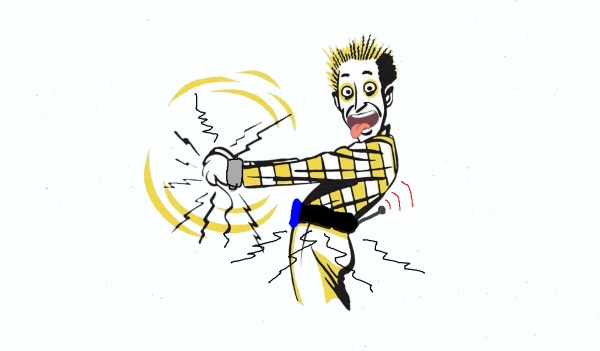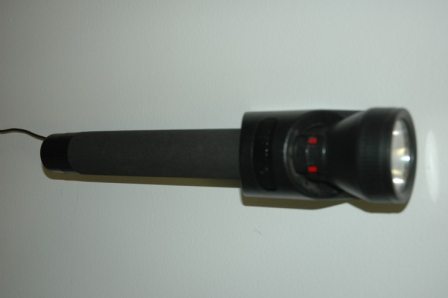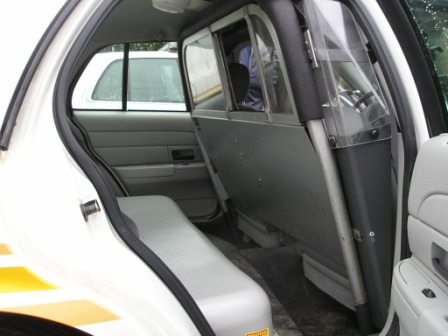An Aluminum Shampoo and a Shocking Experience … OUCH!
Times sure are a-changin’. Why, I remember the days when we cops carried only our sidearms, handcuffs, a portable radio that only worked when you were near civilization, and a leather SAP or blackjack to help fight off people who wanted to do us harm.
Back “in the day” officers didn’t have the luxury of fancy equipment. There were no Tasers. No pepper spray. No barriers between front and rear seats in patrol cars. No bullet-resistant Kevlar vests. No semi-automatic firearms. No rubber bullets. No bean bags. Instead, we relied on fast talking and sheer muscle power to get out of jams.
An Aluminum Shampoo. OUCH!
Sometimes, since we often worked alone patrolling an entire county, the only thing that kept us from getting hurt, badly, was using a flashlight to deliver a gentle “love tap” to an attacker’s thick skull (an aluminum shampoo). Of course, that’s no longer an option due to laws and/or department policies, but the tactic saved my butt more than once. Hey, you do what you have to do to survive, right?
Rechargeable flashlight mounted inside patrol car
However, things, tactics, and equipment evolved. Cops soon found that a ton of new tools were available to help defend themselves and to assist with making safe arrests.
We were giddy when we first received chemical sprays that actually stopped most people in their tracks. Cool! That meant less use of brute strength to gain control of combative suspects. The availability of those sprays also meant we could then bring someone into compliance without the use of striking instruments/impact weapons (blackjacks, batons, etc.). Less injuries for everyone involved—bad guys, cops, and bystanders.
They Gave Us TASERS!
A TASER delivers an electrical charge that disrupts muscle function. The devices are carried on the officer’s non-gun side, and they’re often marked with bright colors. The purpose of these two important details is to prevent officers from confusing the non-lethal TASER with their definitely lethal handgun.
Stun Cuffs
These specially designed handcuffs are capable of delivering an electrical charge to the wearer. They’re are often used when transporting prisoners, especially potentially dangerous or high-risk inmates.
Stun belts are also available, especially for use in prisons. Prison guards/corrections officers (CO’s) train with the belts and are often called on to demonstrate its effects. Officers refer to the experience as “riding the belt.”
 An Ohio sheriff’s deputy left the courtroom for a bathroom break. A few moments later the man in his custody, who wore a stun belt, was hit with a series of electric shocks because the officer accidentally dropped the remote control for the stun belt into the toilet. When drying the controller, the action activated the belt which repeatedly zapped the subject with electrical charges. The judge declared a mistrial. The “shocked” prisoner was cleared medically and suffered no permanent harm.
An Ohio sheriff’s deputy left the courtroom for a bathroom break. A few moments later the man in his custody, who wore a stun belt, was hit with a series of electric shocks because the officer accidentally dropped the remote control for the stun belt into the toilet. When drying the controller, the action activated the belt which repeatedly zapped the subject with electrical charges. The judge declared a mistrial. The “shocked” prisoner was cleared medically and suffered no permanent harm.
The Gentle Grasp of the Behemoth’s Skillet-Size Hands – A True Story
Once, while arresting a very unruly man, a guy who just happened to be twice my size (and I’m not small), my future prisoner decided he was allergic to handcuffs. And, during a brief struggle to free himself from the source of his allergies, my neck somehow wound up in the gentle grasp of the behemoth’s skillet-size hands. In other words, he was choking me with every ounce of strength he could muster up. I couldn’t breathe and I knew then how it must feel to be icing inside a pastry bag, because he was squeezing so hard that I thought my eyes would pop out of their sockets at any moment.
The thug had me pinned against a wall in a position that made going for my gun (a .357 in those days) impossible. However, I finally managed to get a hand on my metal Maglite. So I starting swinging (short strokes because of the odd angle), hoping to force the guy to release his grip. Finally, after a few hard whacks to his head he let go. And, as they say, it was game on!
Smith and Wesson Model 19 (.357)
I finally got that big moose handcuffed and delivered him to the jail. But, my car was not equipped with a cage to put him in for safekeeping (none of our cars had cages back then), so I made him ride up front with me. And I made a point to let him know that my gun was in my hand with my finger on the trigger and if he so much as looked at me wrong I’d shoot him.
I was physically and mentally drained. My body was running on instinct and adrenaline. I was glad that he did choose to sit quietly because I truly didn’t feel like cleaning up the mess in my patrol car after unloading my six-shooter into the mass of muscle sitting in the passenger seat. But I was serious and he knew it, so he behaved nicely on the ride in. He didn’t like it, but the idea of me using a half-dozen lead pellets to aerate his body must not have appealed to him.
Aluminum and Plexiglass divider, a luxury our sheriff did not believe was necessary. He thought that we should should be strong enough and tough enough to manhandle our way out of every situation. He was definitely a bit caveman-ish in his way of thinking, and also believed that female deputies shouldn’t carry guns and that their place was in the office answering the phone and working the radio.
We must have been a real sight when we arrived at the jail—clothes torn, badge ripped from my shirt, bloody lips, flashlight-shaped knots on his head, fingerprint-shaped bruises on my neck, and more. But that was how it was back then, in the good ‘ol days …
Blackjacks and SAPs
The term SAP evolved from (per Wikipedia): A late 19th century type is a wooden shaft about one foot long, with a leather- or macrame-covered lead ball as the head. This weapon is referred to by some sources as a “sap” (derived from “sapling” due to its wood handle). Of course today’s SAPS and blackjacks are a bit different (see video below).
It’s rare to see an officer carrying a SAP/blackjack these days. In fact, many departments banned their use because they’re capable of breaking bone and other damage/injury. Back in the day, though, SAPs were widely carried by officers, and even our uniform pants had “SAP pockets” designed to holding the beavertail-shaped weapons.
There are various types of SAPs, slapjacks, and black jacks. In each, the ends are filled with lead or other hard items. If lead is used it’s often either …
- Lead powder
- Lead shot (similar to buckshot)
- Lead clay, molded to the shape of the SAP
There are different types and styles of Blackjacks/Saps/Slapjacks. They are …
- Round body with a flat or coiled spring in the handle. The spring provides a whip action that delivers a more forceful blow than other types.
- Flat body with a flat or coiled spring in the handle.
- Round body without spring in handle.
- Flat body without spring in the handle (SAP).
- Sap Gloves (lead is fitted into the palm area).
- Palm Saps – same as above, but this one is a handheld object. Sort of like striking someone with a rock.
Each of the above are small enough to fit into an officer’s back pocket.
When departments began banning the use of SAPs and blackjacks, officers soon discovered that metal flashlights (Maglites, for example) were a fantastic substitute. But, the use of flashlights as a defensive impact weapon was not taught in police academies, so they, too, were banned as official weapons.
Impact Weapons
Here’s a video showing and describing various types of blackjacks/impact weapons.
MURDERCON 2021
REGISTRATION IS OPEN!

2021 MurderCon takes writers behind the scenes, into places not typically traveled by anyone other than law enforcement and forensics experts.
I urge you to take advantage of this rare opportunity. It may not pass your way again.
MurderCon is a “killer” event!
Seats at this unique event for writers are LIMITED!








